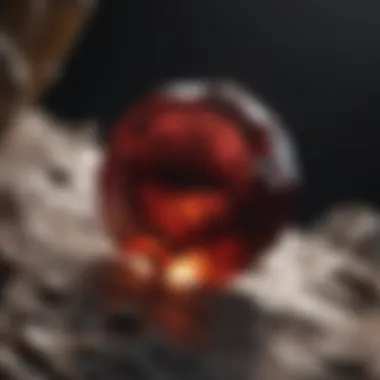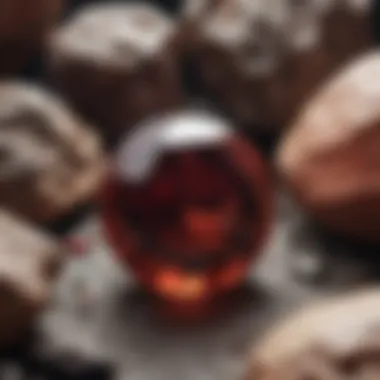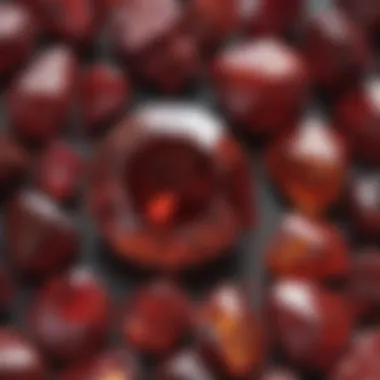Unveiling the Fascinating Hardness of Garnet: A Detailed Guide for Collectors


Rock and Fossil Identification
Garnet, with its remarkable hardness and unique physical properties, stands out as a mesmerizing gemstone coveted by rock and fossil collectors worldwide. Understanding the crucial aspects of rock and fossil identification is paramount when exploring the world of garnets. Identifying different types of rocks and fossils requires keen observation skills and in-depth knowledge. Characteristics such as color, luster, and crystal structure play pivotal roles in distinguishing various specimens. Utilizing specialized tools like hammers, chisels, and magnifying glasses enhances the precision of identification processes.
Collecting Strategies and Methods
Delving into the realm of garnet collection requires enthusiasts to employ best practices and techniques to ensure successful acquisitions. Rock and fossil collectors must strategize effectively to locate prime sites for garnet exploration. Researching geological maps and collaborating with local experts can significantly aid in identifying lucrative collecting locations. Implementing safe extraction procedures is essential to preserve both the specimens and the environment. Leveraging tools like rock hammers, shovels, and safety goggles enhances the efficiency and safety of specimen extraction.
Conservation and Exhibition
Preserving garnet specimens is a crucial element of rock and fossil collecting, necessitating the application of specialized techniques for long-term conservation. Adopting proper storage methods, such as using acid-free containers and moisture-controlled environments, helps maintain the integrity of garnets. When it comes to displaying these precious gemstones, enthusiasts can unleash their creativity by incorporating various mediums like shadow boxes, display cases, or custom-made stands. Thoughtful exhibition of garnets adds value to collections and allows for admiration of their beauty.
Geological Revelations
Exploring the geological insights embedded within garnets unveils a deeper understanding of Earth's processes and history. Appreciating the diverse formations and processes that lead to garnet deposition enriches collectors' knowledge and appreciation of these gemstones. Delving into the historical significance of garnets reveals their roles in ancient civilizations and modern industry, enriching the narrative behind these captivating minerals. Studying notable discoveries in the field of garnet geology provides valuable insights into groundbreaking research and advancements in the study of gemstones.
Introduction to Garnet Hardness
Exploring the Mohs Scale of Hardness
The origin and significance of the Mohs Scale
When we unravel the origin and significance of the Mohs Scale of Hardness, we encounter a pivotal tool that revolutionized mineral identification. Developed by Friedrich Mohs in 1812, this scale quantifies the scratch resistance of various minerals based on the principle of one mineral scratching another. The Mohs Scale offers a practical and accessible method for assessing the hardness of minerals, making it a cornerstone in the field of geology and gemology. Its simplicity and effectiveness make it an indispensable asset for rock and fossil collectors keen on differentiating between gemstones based on their hardness.
The role of hardness in mineral identification


As we delve into the role of hardness in mineral identification, we uncover the fundamental role that hardness plays in distinguishing between minerals with similar appearances. The hardness of a mineral influences its durability and susceptibility to abrasion, aiding collectors in authenticating and categorizing their specimens. By understanding how hardness affects mineral properties, collectors can refine their classification techniques and enhance the accuracy of their collections. Incorporating hardness as a criterion for mineral identification adds a layer of precision and sophistication to the exploration and study of gemstones.
An Insight into Garnet's Composition
The chemical structure of garnet
In investigating the chemical structure of garnet, we encounter a complex interplay of elements that define the unique characteristics of this gemstone. Garnet, with its general formula A3B2(SiO4)3, consists of a diverse group of minerals sharing similar crystal structures. This structural integrity contributes to garnet's hardness and durability, making it a popular choice for jewelry and industrial applications. Understanding the intricate chemistry behind garnet enriches our appreciation for its distinctive properties and aesthetic appeal.
Varieties of garnet and their hardness levels
Exploring the varieties of garnet and their associated hardness levels reveals a spectrum of colors, compositions, and physical attributes that shape the identity of each variant. From the deep red hues of Almandine to the vibrant greens of Tsavorite, each garnet variety possesses unique hardness levels influenced by factors such as mineral impurities and crystal lattice structure. Collectors seeking to expand their knowledge of garnet will find that familiarizing themselves with the diverse array of garnet varieties enhances their ability to discern between specimens and appreciate the diversity within this gemstone category.
Characteristics of Garnet Hardness
Garnet hardness plays a vital role in the world of geology and gemology due to its significant physical properties. When exploring the characteristics of garnet hardness, enthusiasts are introduced to a spectrum of color variations that directly correlate with varying degrees of hardness. Understanding these color variations provides insight into the mineral's composition and structural integrity. For collectors and researchers alike, the transparency levels of garnet are equally crucial as they influence its overall hardness. Different levels of transparency not only affect the gem's brilliance but also impact its resistance to scratching and abrasion. Appreciating these elements enhances one's knowledge of garnet characteristics and aids in identifying and appreciating these mesmerizing gemstones.
Physical Properties of Garnet
Color variations and their relation to hardness
Discussing the color variations of garnet in relation to hardness unveils a fascinating aspect of this mineral. The diverse range of colors, from deep reds to vibrant greens, signifies distinct mineral compositions and levels of hardness. Garnets with darker hues often exhibit higher levels of hardness due to their mineral content, making them sought after for their durability and resilience. On the contrary, lighter colored garnets may possess lower hardness levels but exude a unique brilliance that appeals to collectors. Understanding this relationship between color and hardness enriches the appreciation and evaluation of garnet specimens within the context of this article.
Transparency levels and their impact on hardness
The transparency of garnet gemstones offers further insight into their hardness properties. Gems with high transparency levels tend to have excellent hardness, demonstrating their resistance to abrasion and scratching. Transparent garnets showcase their internal structure and color saturation more vividly, enhancing their overall appeal to collectors. However, the drawback lies in the potential fragility of highly transparent garnets, which require careful handling to prevent damage. Balancing transparency with hardness is a key consideration when evaluating garnet specimens and integrating them into collections, as transparency directly influences the gem's beauty and durability within the themes explored in this article.


Unique Hardness Features of Garnet
Garnet's resistance to scratching and abrasion
One of the standout characteristics of garnet is its remarkable resistance to scratching and abrasion. This hardness feature sets garnet apart from other gemstones, making it a preferred choice for jewelry and collection purposes. With a high level of durability, garnet exhibits minimal signs of wear over time, retaining its luster and beauty. Rock and fossil collectors benefit from garnet's resistance to scratching, as it ensures the longevity and integrity of their specimens. By elaborating on garnet's unique hardness properties, this article aims to underscore its practical value in the context of specimen preservation and collection enhancement.
How garnet compares to other gemstones in terms of hardness
Comparing garnet to other gemstones regarding hardness sheds light on its exceptional qualities. Garnet ranks relatively high on the Mohs scale, indicating its superior hardness compared to popular gemstones like quartz or topaz. This attribute makes garnet a preferred choice for jewelry designs that require durable gemstones capable of withstanding daily wear. Understanding how garnet's hardness stacks up against that of its counterparts offers collectors and enthusiasts valuable insights into its versatility and strength. By delving into this comparative analysis, readers can appreciate garnet not only for its beauty but also for its robustness as a gemstone, making it a standout addition to any rock or fossil collection devoted to hardness exploration.
Practical Applications of Understanding Garnet Hardness
Garnet's hardness plays a crucial role in various practical applications for rock and fossil collectors. Understanding the hardness of garnet enables collectors to differentiate between different minerals based on their resistance to scratching and abrasion. This knowledge is pivotal in gemstone identification, where the hardness of garnet can help distinguish it from other similar-looking stones. Additionally, by comprehending garnet's hardness, collectors can make informed decisions on suitable tools and techniques for testing the gemstone's hardness. Taking care to maintain the hardness of garnet specimens also ensures their longevity and luster, adding value to a collector's assortment.
Utilizing Garnet Hardness in Identification
The significance of hardness in gemstone identification
The significance of hardness in gemstone identification lies in its reliability as a diagnostic tool. By assessing the hardness of a gemstone using the Mohs Scale, collectors can confirm its identity and differentiate between similar-looking minerals. Garnet's specific hardness level on the scale provides a distinct benchmark for identification, aiding collectors in their categorization efforts. This aspect of garnet's hardness is particularly advantageous for rock and fossil collectors seeking accuracy and precision in gemstone identification, enhancing their overall expertise.
Tools and techniques for testing garnet hardness
Utilizing tools and techniques for testing garnet hardness is essential for collectors to accurately assess the gemstone's resistance to scratching and abrasion. Various instruments such as hardness picks and scratch plates can aid in determining the specific hardness level of garnet. These tools not only facilitate practical identification processes but also contribute to a collector's proficiency in evaluating gemstone properties. While there are advantages to using specific tools for testing garnet hardness, collectors must also be mindful of the limitations and nuances involved in interpreting the results accurately, ensuring a thorough understanding of the gemstone's physical characteristics.
Preservation and Care of Garnet Specimens


Best practices for maintaining garnet's hardness and luster
Implementing best practices for maintaining garnet's hardness and luster is essential for preserving the gemstone's integrity over time. Strategies such as storing garnet specimens in separate compartments to prevent scratching and avoiding exposure to harsh chemicals can prolong their durability and visual appeal. By following these guidelines, collectors can safeguard the hardness and luster of their garnet specimens, ensuring their long-term quality and desirability within their collection.
Avoiding common pitfalls in preserving garnet specimens
Avoiding common pitfalls in preserving garnet specimens is crucial to prevent damage and deterioration. Common mistakes such as improper cleaning methods or storing garnet specimens in direct sunlight can impact their hardness and luster negatively. By being aware of these pitfalls and taking proactive measures to mitigate risks, collectors can maintain the pristine condition of their garnet specimens effectively. This proactive approach to preservation not only enhances the longevity of the gemstones but also preserves their intrinsic beauty for future generations of collectors.
Enhancing Your Collection with Garnet Knowledge
In this section of our comprehensive guide, we delve into the significance of enhancing collection prowess with in-depth garnet knowledge. Rock and fossil collectors aspiring to elevate their expertise will find this segment particularly enlightening. By exploring various aspects of garnet, collectors can broaden their understanding of gemstones and enhance the diversity of their collections. The incorporation of garnet specimens offers a unique opportunity to add depth and complexity to existing rock and fossil displays. Understanding the distinct properties and varieties of garnet allows collectors to appreciate the nuances and beauty of this fascinating gemstone, adding a layer of sophistication to their collections.
Incorporating Garnet into Your Collection
Exploring different garnet varieties for collecting:
Diving into the realm of garnet varieties enhances the overall allure of a collector's trove. From the fiery brilliance of Almandine to the exotic allure of Spessartine, each variety brings its own charm and appeal. Exploring these diverse garnet types provides collectors with a rich tapestry of colors, textures, and compositions to enrich their collections. The unique characteristic of each garnet variant contributes to the overall aesthetic and educational value, making them sought-after additions to any collection.
Displaying and showcasing garnet specimens effectively
Effectively presenting garnet specimens is crucial to highlighting their beauty and allure. Choosing the right display method can accentuate the unique features of each specimen, drawing attention to their individual intricacies. Whether showcased in a well-lit cabinet or under specialized lighting to enhance transparency, the display of garnet specimens plays a vital role in captivating viewers. By understanding how to effectively present these gemstones, collectors can create visually stunning exhibits that showcase the true magnificence of garnet varieties.
Educational Value of Garnet Hardness
Teaching opportunities using garnet hardness as a lesson
Exploring garnet hardness provides a valuable educational tool for enthusiasts and educators alike. By incorporating lessons on garnet hardness, collectors can delve into geology, mineralogy, and lapidary arts with practical examples. Understanding the Mohs scale through garnet offers a hands-on approach to learning about mineral hardness, enhancing the educational experience. Through interactive lessons on garnet hardness, educators can engage students in a tactile exploration of geological concepts, fostering a deeper appreciation for gemstones and minerals.
Imparting knowledge about garnet to others in the community
Sharing knowledge about garnet within the community fosters a sense of camaraderie and mutual learning among enthusiasts. By imparting insights into the world of garnet, collectors can inspire others to explore the beauty and complexity of this gemstone. Educating the community on garnet's properties, origins, and significance nurtures a culture of appreciation for Earth's treasures. Through workshops, seminars, or public exhibitions, collectors can ignite a passion for garnet and geology, creating a ripple effect of curiosity and exploration within the community.







